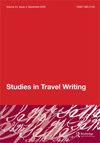Verticality in the peripatetic genre: deceleration, microspection and confinement in Robert Macfarlane’s travel books
Q2 Arts and Humanities
引用次数: 1
Abstract
ABSTRACT This article proposes a discussion of Robert Macfarlane’s travel series The Wild Places (2007), The Old Ways (2012) and Underland (2019), with a close focus on pedestrianism. The peripatetic aspect of these books can be understood as a mode of writing in which the rhythm of the walk settles into the rhythm of the text and a mode of locomotion, in which pedestrianism emerges as a vantage point of perceiving the world. At the same time, this interpretation draws upon the concept of verticality, with its key instruments of deceleration, microspection, multisensory engagement in the outer world, physical proximity and confinement. The unorthodox use of tactility, pedestrian senses and privileging of the tactile-kinaesthetic sustain the idea of a body–subject and disrupt the supremacy of sight and a growing sense of disembodiment in the travel genre. By and large, Macfarlane’s celebration of the metaphysics of place questions conventional horizontalism.漫游类型中的垂直性:罗伯特·麦克法兰旅行书中的减速、微观视角和禁闭
本文旨在探讨罗伯特·麦克法兰(Robert Macfarlane)的旅行系列作品《荒野》(2007)、《老路》(2012)和《地下世界》(2019),重点关注徒步旅行。这些书的漫游方面可以理解为一种写作模式,其中步行的节奏融入了文本的节奏,以及一种运动模式,其中步行成为了感知世界的有利位置。与此同时,这种诠释借鉴了垂直性的概念,其关键工具包括减速、微观观察、外部世界的多感官参与、物理接近和限制。非正统地使用触觉、行人感官和触觉动觉的特权,维持了身体主体的观念,破坏了视觉的至高无上性和旅行类型中日益增长的分离感。总的来说,麦克法兰对地方形而上学的颂扬质疑了传统的水平主义。
本文章由计算机程序翻译,如有差异,请以英文原文为准。
求助全文
约1分钟内获得全文
求助全文
来源期刊

Studies in Travel Writing
Arts and Humanities-Literature and Literary Theory
CiteScore
0.40
自引率
0.00%
发文量
13
期刊介绍:
Founded in 1997 by Tim Youngs, Studies in Travel Writing is an international, refereed journal dedicated to research on travel texts and to scholarly approaches to them. Unrestricted by period or region of study, the journal allows for specific contexts of travel writing to be established and for the application of a range of scholarly and critical approaches. It welcomes contributions from within, between or across academic disciplines; from senior scholars and from those at the start of their careers. It also publishes original interviews with travel writers, special themed issues, and book reviews.
 求助内容:
求助内容: 应助结果提醒方式:
应助结果提醒方式:


